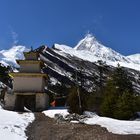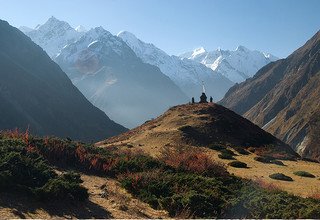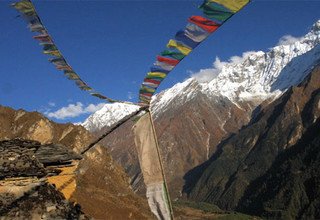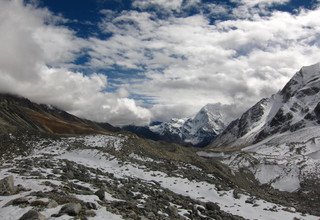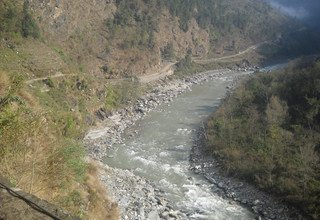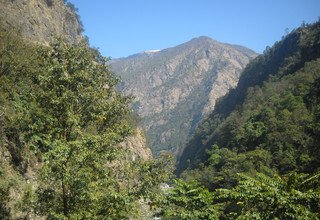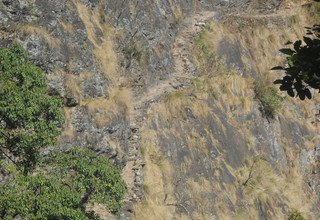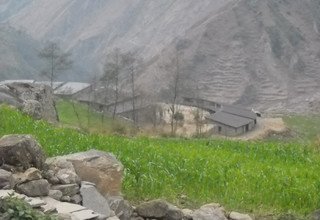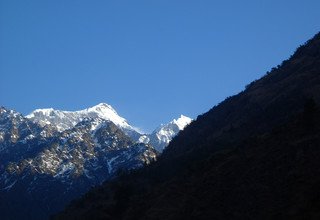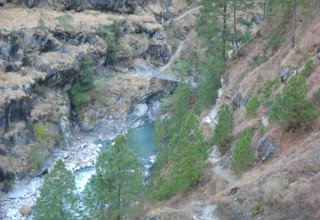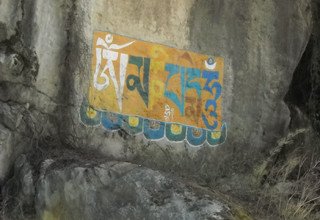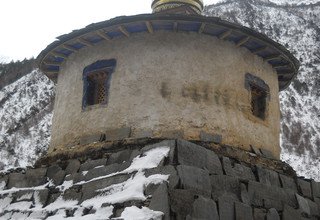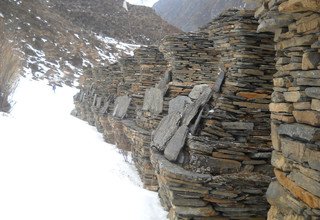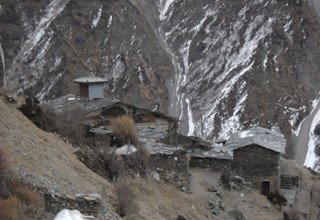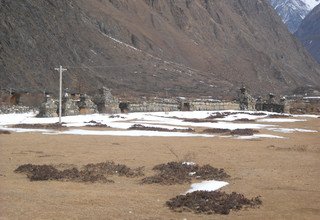Tsum Valley Trek Itinerary
Day 1: Arrival in Kathmandu 1338m
Arrival in Kathmandu Tribhuvan International Airport and you will be met at the airport by our representative who will be waiting with a Swiss Family Treks sign outside the terminal and transfer to Hotel by private car. Welcome drink and after you settle into the hotel there will be a group briefing with your tour leader. He will discuss the trek details and co-ordinate any last minute arrangements. Overnight at 4-star hotel in Kathmandu.
Day 2: Permit Procedure and Full Day Guided Sightseeing Tour in Kathmandu Valley by private vehicle
After breakfast in the hotel, Drive to Swayambhunath Stupa which is very close form the centre of Kathmandu. It takes some minutes to be there. This Temple is also known as Monkey Temple which is considered to be self made Stupa. Then visit to Boudhanath Stupa: the biggest stupa in Nepal and one of the bigger stupa in the world. You can basically experience Tibetan Buddhism, culture and way of life in Boudhanath Area. Boudhanath area is the authentic place to buy Tibetan stuffs. Again you will be visit Pashupatinath Temple and it is one of the most sacred temples in the entire Hindu world. It is a sacred place where Hindus come to die and to be cremated. The temple of Pashupatinath is a large double roofed, gilt pagoda, decorated with brass, the gateway is plated with silver. There are images of Shiva along with other statues, shrines and temples dedicated to other deities in the complex. A circuit of the Pashupati area takes visitors past a sixth-century statue of the Buddha, an eight-century statue of Brahma the creator and numerous other temples. There are rows of Shiva shrines and Hindu pilgrims from all over south Asia offering ceremonies to worship Shiva, the Lord of Destruction. Overnight at 4-star hotel in Kathmandu.
Day 3: Drive from Kathmandu to Machha Khola 870m/7-8 hours by private 4W vehicle
A westward picturesque ride along the Prithvi Highway, via the lush hills, leads us to Malekhu. Then, driving past Dhading Besi, the road turns curvy and leads us uphill to Gola Bhanjyang where enthralling views of snow-capped mountain peaks can be seen. The road then goes downhill to cross Ankhu Khola, and later, at Arughat, we meet Budhi Gandaki River. A further drive up the west bank of Budhi Gandaki River finally brings us to Machha Khola. Overnight at a lodge in Machha Khola.
Day 4: Trek from Machha Khola to Jagat 1370m/6-7 hours
Continue up and down over a couple of ridges to Tatopani (930m; ‘hot water’) where there are hot water spouts under the sheer cliffs that provide a delightful evening shower. Climb over a ridge and cross the Buri Gandaki on a rickety suspension bridge, climb on well made marble stairs in the narrow valley for some time and through Doban (1000m; Duvan). Shyaule Bhatti 1hr later has large rock with views where you can take tea and look at the wild gorges ahead. After crossing a landslip and the bridge across the Yaru Khola (1363m), emerge onto river flats for lunch at Yaru (1140m) at the Sandbar Hotel. Look downstream at the massive rock fall that chokes the river. Just past Yaru, cross to the left bank and enjoy easy up and down to Jagat (1410m), a neatly Flag stoned Gurung village where Jagat (‘tax’) is collected on Tibetan trade. There’s a small lodge here and you will need to show your MCAP permit. In this area, potato, maize and climbing beans are all planted at the same time — the potato for food and to suppress weeds, the maize for food and to supply a trellis for the beans, which are an important source of protein. Marijuana is a major weed problem. Walk up the riverbed then climb over a rocky ridge to Salleri (1440m) with views of Sringi Himal (7187m). Overnight at a lodge in Jagat.
Day 5: Trek from Jagat to Lokpa 2240m/5-6 hours
Morning descend to Sirdibas (1430m; Setibas, Tara) where there is said to be a lodge. You’ll see your first signs of Buddhist culture here. Continue up-river on the left bank, up and down before crossing Nepal’s longest suspension bridge to the east bank and a tiring climb up to prosperous Philim (1590m; Dodang) surrounded by rich fields of maize, potato and millet. If you are not taking the Tsum Valley side-trip then today you will continue on to Ghap towards the Larkya-La. Traverse north out of Philim on the obvious track signposted to the Larkya-La, through some pretty forest with views up the narrowing valley. After 1hr climbing enter the increasingly misnamed Ekle Bhatti (1600m; ‘lone teashop’) with at least six bhatti, then traverse high above a spectacular gorge, entering a largely uninhabited area of pine trees. Eventually drop to a trail junction going left to Ghap and right to the Tsum Valley. Climb on a well-graded but exposed track through pines and rhododendrons, looking down on the other trail across the river. If the slopes here have recently had their annual burn there is a real risk of stone fall from the cliffs above, especially if there are goats grazing. Climb on zigzag steps, increasingly exposed, and gain your first glimpses of the narrow lower Tsum Valley, very steep across the Shiar Khola which drains from the very top of the valley. Across the Buri Gandaki is Himalchuli (7893m) above steep cliffs. Walk through a largely intact and peaceful temperate forest into Lokpa (2240m; Lakuwa), surrounded by barley fields, where there is a comfortable lodge, toilet. Overnight at a lodge in Lokpa.
Day 6: Trek from Lokpa to Chumling 2360m/4-5 hours
Descend through beautiful forest, crossing three side streams (one shown wrongly on the Map as Shiar Khola) on bridges, circle under a huge bluff on the river then climb steeply on well-made but exposed stairs. After about 30mins start to traverse north through pines and rhododendrons, still climbing and with very steep slopes. The hidden valley of Tsum stretches enticingly ahead. Eventually descend to a lone bhatti Ghumlong (2130m) on the river. The path straight ahead climbs steeply to Ripchet (2470m; Ripche) in about 1hr; the path to Chumling (2360m) crosses the Shiar Khola on a wooden bridge and up. It is not for those afraid of heights - several locals have fallen to their death from this track while drunk. Make sure you climb up to Chumling and check out the old gompa, the traditional houses, orchards, clinic and beautiful stone streets. This is Buddhist agriculture, with conical pine needle haystacks among the 4 prayer flags. Overnight at a lodge in Chumling.
Day 7: Trek from Chumling to Chhokangparo 3030m/6-7 hours
From here on trails are lined with artistic chortens and mani walls made of thousands of stone slabs carved with deities and prayers. An easier day after yesterday, Cross the suspension bridge just east of the hotel and traverse through rich farming land of maize and potatoes. The houses are classic Tibetan with barricades of firewood on the roof, but without flat roofs as it rains and snows here. Cross a huge slip where rocks and flood cleared the area even up onto the opposite bank, killing five in 1999, but is now covered with a forest of new trees. Up the valley to the east are superb views of the 7000m Ganesh Himal, of long suspension bridges on the opposite bank, and far above the perched village of Ripchet (2468m). Lunch is possible at Rainjham (2400m), a single bhatti with enclosed courtyard. Cross the Serpu Khola and climb for 2.5hrs on well-graded but exposed track to upper Tsum and the large village of Chhokangparo (3010m), stone houses nestled under cliffs without a single iron roof. The valley opens here into spacious fields of barley, maize, buckwheat and potato, but wheat has been abandoned due to ‘hill bunt’, a disease which turns the heads black and causes total crop failure. Herds of Thar often graze the wild cliffs to the north, coming right down to the fields. If the air is clear Himalchuli (7893m) can be seen down valley. Overnight at a lodge in Chhokangparo.
Day 8: Trek from Chhokangparo to Nile 3360m/3-4 hours
Most people can climb to 2800m without getting altitude sickness, but the altitude gain in these track notes above Chhokangparo exceeds the 200m per day suggested for safety. Watch for signs of altitude sickness and be prepared to rest or retreat if they emerge. Take time to explore the joined villages of Chhokang and Paro and climb north to a retreat where Lama Kongchog died after 26 years of meditation. His child reincarnation, found in the village, was subject of the award-winning DVD Unmistaken Child (available in Kathmandu). Thar are often sighted near here. The friendly people speak Tsumba, related to Tibetan, but often little Nepali and are quite unused to visitors. Head east through small villages and past a local school, climb over a ridge of chortens and past Lamagaon (3202m) through the flat fields, looking across the extensive crops and river to the huge courtyard of the Rachen Gompa (3240m). This nunnery is the female equivalent of the main Kathmandu Kopan Monastery. Climb up and visit Milarepa’s Cave (Piren Phu), where the bringer of Buddhism to Tibet is reputed to have meditated. The cave is being extensively restored. Cross the Shiar Khola, pass through hamlets of Phurbe (3251m) and Pangdun (3258m) and pass an unusual round stupa before reaching the larger village of Chhule (3347m) through an impressive entrance gate (kani). The children here all wear the Tibetan dressing gown called chubas and there are many yaks. Head upstream to cross the bridge and climb to Nile (3361m; Nyile). Both villages are in traditional style with inclusion of livestock compounds into the houses and sheltered verandahs for drying crops. Overnight at a lodge in Nile.
Day 9: Trek from Nile to Mu Gompa 3700m and back to Chhokangparo 3030m/6-7 hours
Leave your rucksack behind. Make an early start up valley on the west bank, enjoying sunrise on the narrowing valley walls, yaks being put to pasture and a day with just a light pack. The final climb up to the large Mu Gompa (3700m; Mugumba) is through dry Tibetan country, with rows of chortens and widening mountain vistas. This is a large monastery with over 100 monks and an ancient gompa visited by David Snellgrove (Himalayan Pilgrimage) in 1956. If time permits you can also visit Dhephyudoma Gompa (4000m) further west on an obvious track. On three sides now are tantalizing views of the border with Tibet, with frequently used passes to the east (Ngula Dhojyang or Mailatasachin Pass, 5093m) and west (Thapla Bhanjyang, 5104m) just out of sight. Some people climb to Kalung (3820m). Making a daytrip to the passes for a view into Tibet. There are extensive seasonal yak pastures in all directions, the Lungdang Glacier to the east and high peaks in all directions. Return down valley through Chhule, collect your rucksack and continue down as far as Phurbe, but stay on the east bank of the Shiar Khola and cross flat boulder-covered plains to Rachen Gompa (3240m), where it is possible to inspect the ancient gompa if you want. Camping is also available. The older part of the nunnery is more interesting. Families in the Tsum usually have at least one family member as either a monk or a nun. Continue south until a bridge crosses to the west bank then descend again to Chhokangparo. Overnight at a lodge in Chhokangparo.
Day 10: Trek from Chhokangparo to Gumba Lungdang 3200m/5-6 hours
Drop below Chhokangparo on the previous trail for about 2hrs, until a small gompa is reached at Gho (2485m). Descend on a narrow trail to the left through the village and drop to a wooden bridge over the Shiar Khola. Cross the bridge to Dhumje (2440m, Tumje) which has a Tibetan herbal medicine clinic and school. The track onwards climbs just behind the clinic. Climb very steeply on an indistinct track through pines and rhododendrons until the track starts traversing at a mani wall with prayer flags. The track is exposed and narrow. Finally, in the pine forest, take an uphill trail and make a steep zigzag climb through huge silver pines to reach Gumba Lungdang (3200m), perched on a ridge with small cells for the nuns through the beautiful rhododendrons above. This small gompa with 40 nuns has an intense and engrossing puja every night. The mountain views in all directions are amazing. Overnight at Monastery's dormitory room in Gumba Lungdang.
Day 11: Day trip to Ganesh Himal Base Camp 4500m/7-8 hours
Your guide will be required for this trip since the track is poorly marked. Circle from the gompa past the nuns’ housing, drop on dusty or muddy zigzags to regain the lower track and continue up valley on a rocky indistinct track through the forest. Cross the Laudang Khola to the west bank on a rickety wooden bridge and climb steeply through pristine pines and rhododendrons on a ridge. There is a hut in a kharka about halfway up, with the track continuing behind it, then up a birch-lined dry creek bed and eventually you emerge into grassy flats behind the lateral moraine of the Toro Gompa glacier. Continue climbing past seasonal yak huts and you will find a track on the moraine wall that gives superb views of the Cirque of mountains. The camp is somewhere about here. It takes about 4hrs to reach the Ganesh Himal Base Camp (4200m). The map shows another base camp on the east side of the glacier, but there appears to be no obvious track between them, so return to Gumba Lungdang in time for the evening puja by retracing your steps. Altitude can make this day difficult for some, but the intact forest wilderness and views make it an outstanding trip. Overnight at Monastery's dormitory room in Gumba Lungdang.
Day 12: Trek from Gumba Lungdang to Lokpa 2240m/7-8 hours
This can be a taxing day so start early. Descend from Gumba Lungdang by the upward track. In Dumje cross the Laudang Khola and stay on the south bank of the Shiar Khola (contrary to the map). Climb over some very deep gorges and shaky cantilever bridges to picturesque Ripchet (2470m; Ripche). Take time to look around at this perched fertile valley of barley and buckwheat with evocative chortens in the fields backed by pine forest. Descend on steep stairs to the lone bhatti Ghumlong (2130m) on the river, which you passed through six days ago. Climb again through the pristine temperature forest to Lokpa (2240m). Overnight at a lodge in Lokpa.
Day 13: Trek from Lokpa to Jagat 1370m/7-8 hours
You will descend down towards Philim. You will then trek along the Budi Gandaki River and after few ascends and descends, you will reach Philim. Further, you will descend down, and cross a long suspension bridge over Budi Gandaki River. You will then reach Sirdibas passing through the Gatte Khola. From here, you will go through small villages, and trek on the rocky path to reach Jagat. You will stay overnight at the lodge in Jagat.
Day 14: Trek from Jagat to Machha Khola 870m/5-6 hours
You will descend down to the lower Jagat and trek on the rocky path. You will then cross a suspension bridge and descend down through the forest to reach Yarubagar. You will trek on the rocky trail and walk down through the forest. Further, you cross numerous rivers on multiple occasions and reach Machha Khola. You will stay overnight at the lodge in Machha Khola.
Day 15: Drive from Machha Khola to Kathmandu 7-8 hours by private 4W private vehicle
Today, you will drive back to the Kathmandu on a private 4W vehicle. The route will go through the dusty newly built road to Arughat Bazaar. From here, you will drive towards Gorkha Bazaar with the views of Ganesh Himal ranges and reach Kathmandu. Upon reaching Kathmandu, you will be taken to our hotel. Overnight at a 4-star hotel in Kathmandu.
Day 16: Final Departure from Kathmandu
Your adventure in Nepal comes to an end today! There is nothing to do but trade emails with travel companions and organize the photos. If you have more time you can do some shopping or sightseeing. A representative from our company will take you to the airport approximately 3 hours before the scheduled flight. On your way home you'll have plenty of time to plan your next adventure in the wonderful country of Nepal.
# Pricing for Group Size Basis: (Private Trip - 16 Days Package)
All-inclusive Trek Price for single/individual trekker; USD 2155
All-inclusive Trek Price for 2 trekkers basis; USD 1425 per person
All-inclusive Trek Price for 3 trekkers basis; USD 1330 per person
All-inclusive Trek Price for 4 trekkers basis; USD 1250 per person
Join with Us on a Tsum Valley Trek in 2026/2027.
Customize Your Trek: This is a general itinerary, which can always individually be “tailormade”. The trek package can be redesigned or redeveloped as per your taste, For more information please e-mail us at snftnepal@yahoo.de
Note: In case of emergency during the trip, Helicopter will be arranged by Swiss Himalayan Family Treks and Expedition Pvt. Ltd. The charges must be paid by the clients themselves.
















